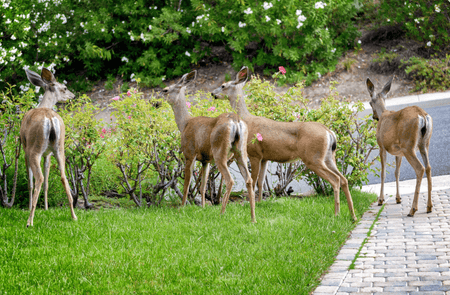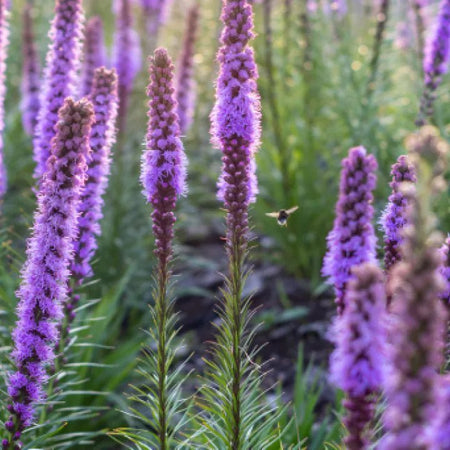The Eastern Texas Gardening Guide

The Ultimate Eastern Texas Gardening Guide
Welcome to Garden for Wildlife's gardening guide tailored specifically for Eastern Texas. At Garden for Wildlife, we are on a mission to transform gardens into thriving wildlife habitats. By planting native flora and embracing sustainable practices, we can create a welcoming environment for fireflies, native bees, hummingbirds, and butterflies.
In this guide, we will explore the native plant collections available for Eastern Texas, the importance of considering local factors, and how to cultivate a garden that supports the diverse wildlife in your region.
Discover your unique garden: Eastern Texas
Eastern Texas boasts a rich diversity of flora and fauna. To create a garden that attracts and supports local wildlife, consider using the Garden for Wildlife ZIP code native plant finder. By entering your ZIP code, you can access tailored plant collections suitable for your location. Keep in mind that factors like sunlight, shade, soil type, and moisture levels are essential considerations when choosing your plants.
USDA gardening zones: Tailoring your garden to Eastern Texas
Understanding your USDA gardening zone is like having a key to unlock the secrets of successful gardening in Eastern Texas. This zone information isn't just a random classification; it's a powerful tool that empowers you to make informed decisions about which plants are most likely to thrive in your specific area.
The USDA (United States Department of Agriculture) has divided the United States into several gardening zones based on climate and temperature data. Each zone represents a range of average annual minimum temperatures. Eastern Texas spans multiple USDA gardening zones due to its size and varying elevations. These zones help categorize regions with similar temperature profiles.
Zones, frost, and growing seasons:
- Gardening zones provide guidance on frost dates, which is crucial information for planting and harvesting. Knowing your zone's frost dates helps you plan your garden calendar effectively.
- Different zones also influence the length of your growing season. Some zones in Eastern Texas have longer growing seasons, allowing for multiple plantings and extended harvests.
Embrace native plants: A haven for Eastern Texas wildlife
Garden for Wildlife is all about celebrating the native plants that make Eastern Texas a haven for wildlife. Why should you consider planting native species in your garden? Let's delve deeper into the reasons behind this approach and explore some remarkable native plants that will bring your garden to life.
The power of native plants
Native plants are the unsung heroes of Eastern Texas landscapes. They have evolved over centuries to thrive in this region's unique climate, soil, and ecosystem. By incorporating native plants into your garden, you're not just adding beauty; you're providing essential resources for local wildlife. Here's why native plants are so important:
- Adaptation to local conditions: Native plants are well adapted to the local environment. They have developed a symbiotic relationship with local wildlife over time, providing food and other habitat essentials for various creatures.
- Biodiversity boost: Eastern Texas is home to a wide range of wildlife, from delicate butterflies to vibrant hummingbirds. Native plants support this biodiversity by offering nectar, pollen, and shelter. They help attract and sustain the local animal and insect populations.
Must-have native plants for Eastern Texas
Now, let's take a closer look at some native plants that can make your Eastern Texas garden a vibrant, wildlife-friendly space:
- Spotted beebalm:

Description: Spotted beebalm is a versatile perennial that showcases its beauty across a range of 1 to 4 feet in height. This plant is characterized by its unique flowering pattern and can thrive in both full sun and part shade conditions. Ideally, it should be planted in sandy, well-drained soil with medium moisture.
Wildlife Benefits: Spotted beebalm is a magnet for a variety of wildlife. Butterflies, caterpillars, and native bees are attracted to the blooms that grace our gardens from April to August. Its alluring fragrance and nectar draw in both birds and hummingbirds, making it a bustling hub of activity during its flowering months.
- Milkweed:

Description: Milkweed comes in various species native to Texas, including orange milkweed and swamp milkweed. They are herbaceous perennials known for their clusters of intricate pink or white flowers. Native milkweed is preferred over tropical milkweed or the invasive butterfly bush, which we do not recommend planting.
Wildlife benefits: While milkweed is famous for its role as the primary host plant for monarch butterflies, it also attracts a range of other pollinators. Bees, wasps, and beetles are among the insects that visit milkweed flowers for nectar. By planting milkweed, you're supporting not only monarchs but also a broader pollinator community.
- Rough blazing star:

Description: The rough blazing star stands as a radiant perennial, reaching heights between 1 to 4 feet. Its stems are adorned with a series of fluffy, star-like blooms that make a dramatic appearance from August to October. Best grown in full sun, this plant thrives in soil that is rich in organic material and prefers well-drained conditions. With its spread between 1 to 1.5 feet, it makes an excellent choice for gardeners looking to add vertical interest to their spaces.
Wildlife benefits: A true gem for wildlife enthusiasts, the rough blazing star attracts a range of creatures. From butterflies to caterpillars and native bees, this plant is a haven for pollinators. Its vibrant blooms also serve as a beacon for birds, hummingbirds, and other beneficial insects, making it a central hub for nature's activity during its peak flowering months. Plus, its deer resistance ensures that its spectacular display remains uninterrupted for all to admire.
Incorporating these native plants into your Texas garden not only enhances its visual appeal but also contributes to the vitality of your local ecosystem. By attracting hummingbirds, butterflies, and other pollinators, you'll witness the beauty of nature up close while fostering a sustainable and biodiverse environment in your own backyard.
Shop Texas Native Plants for Wildlife
Avoid traditional turf lawns
In our quest to create wildlife-friendly gardens in Eastern Texas, one of the most crucial steps is to rethink the conventional lawn-and-mulch landscape. Garden for Wildlife encourages gardeners to embrace alternative practices that maximize wildlife habitat and promote ecological health. Join us in the anti-lawn movement! Have you heard about Now Mow May?
Traditional lawns, while aesthetically pleasing, are often barren landscapes for wildlife. They provide little to no food, shelter, or nesting opportunities for local animals and insects.
Instead, design yards that incorporate Texas native grasses like prairie dropseed and path rush. While colorful flowers often take center stage in wildlife gardens, the importance of incorporating native grasses should not be underestimated. Native grasses play a crucial role in supporting diverse wildlife, from insects to birds and small mammals, and can be beautiful when placed strategically in your landscape.
Read: Why You Should Plant Native Grasses
Pest control the organic way
Maintaining a thriving garden ecosystem involves managing pests without resorting to harmful chemicals. Garden for Wildlife advocates for organic pest control methods that protect beneficial insects and support soil health.
How to practice organic pest control:
- Ladybugs and lacewings: Attract natural predators like ladybugs and lacewings to your garden. These insects feed on common garden pests like aphids and caterpillars, helping to keep their populations in check.
- Companion planting: Plant companion crops that naturally deter pests or attract beneficial insects.
- Handpicking: Regularly inspect your plants and handpick pests when you spot them. This manual approach can be highly effective for small infestations.
Read More: How Native Plants Help Control Pests and Diseases While Nurturing Wildlife
Supporting local Texas pollinators
Eastern Texas is a treasure trove of pollinators, including native bees that play a crucial role in ecosystem health. To support these essential creatures, consider the following steps:
Providing nesting sites
- Bee boxes: It's easy to support bees with native plants at home in Texas! Install bee boxes in your garden to offer nesting sites for solitary native bees. These artificial homes mimic natural nesting spots, providing a safe haven for these important pollinators.
- Bat Box: vital to our ecosystem, Texas bats play a crucial role in pollination, pest control, and play a crucial role in maintaining the delicate balance of our ecosystems.
- Bare soil patches: Create small patches of bare soil in your garden where ground-nesting bees can construct their nests. This simple gesture can attract a diverse range of native bees.
- Leave the Leaves: The leaf layer is its own ecosystem! A leaf layer a few inches deep is normal where trees and shrubs naturally grow, whether in woodlands, near your garden or on your lawn. Many wildlife species use the leaf layer as their primary habitat: chipmunks, wood frogs, box turtles, toads, shrews, earthworms, millipedes, salamanders, and thousands of insect species. Fallen leaves in autumn also form a natural mulch that helps suppress weeds and fertilizes the soil as it breaks down. Why spend money on mulch and fertilizer when you can make your own?
Planting a variety of native flowers
- Year-round blooms: Select native flowers that bloom at different times throughout the year. This ensures a consistent food source for pollinators, including bees and butterflies, regardless of the season. Make sure you know when to expect emergence from your native plants each year.
- If you want to invite Texas butterflies like the migrating monarch butterfly, selecting a curated collection like Butterfly Banquet is the perfect place for a beginner wildlife garden with Texas native plants.
Welcoming fireflies with East Texas native plants
Few sights are as enchanting as fireflies lighting up the summer night sky. These mesmerizing insects, with their soft, twinkling glow, add a touch of magic to warm evenings in Eastern Texas. To create a welcoming habitat for fireflies and enjoy their enchanting displays, here are some steps you can take.
1. Reduce light pollution in your garden
Light pollution from artificial sources, such as streetlights and outdoor lighting, can disrupt the natural behavior of fireflies. These insects rely on their bioluminescent flashes to communicate and attract mates, a behavior that is easily disturbed by excessive artificial lighting.
How to Reduce Light Pollution:
- Use soft lighting: Opt for soft, warm-colored outdoor lighting fixtures with minimal glare. Shielding or directing lights downward can help prevent light from dispersing into the night sky.
- Install motion sensors: Consider motion-activated lights that only illuminate when needed. This reduces unnecessary light pollution during quiet moments in your garden.
- Turn off unnecessary lights: Make a habit of turning off outdoor lights when you're not using them. This not only benefits fireflies but also conserves energy.
2. Plant tall grasses and native shrubs for shelter and resting spots
Fireflies spend the daylight hours resting and taking cover in tall grasses, native shrubs, and other vegetation. Providing suitable habitat for them is essential for their survival and reproduction.
How to plant for firefly habitat:
- Create layers: Arrange plants in layers to provide various heights and cover options for fireflies. Tall native Texas grasses can serve as daytime resting spots, while Texas native shrubs offer protection from predators.
- Avoid pesticides: Refrain from using chemical pesticides in your garden. These substances can harm fireflies and other beneficial insects. Opt for organic pest control methods to maintain a balanced ecosystem.
By following these guidelines, you can transform your Eastern Texas garden into a thriving wildlife habitat. Garden for Wildlife is committed to helping you make a positive impact on local ecosystems. Remember, every small step you take towards creating a wildlife-friendly garden contributes to a healthier environment for all.
Read more: How to Attract and Build a Firefly-Friendly Habitat
If this guide has enriched your gardening journey, share it with fellow Texas gardeners and help us to keep spreading the green message.

Find Native Plants by Zip Code
We took the guesswork out of planting native. Check your zip to see what ships!




















